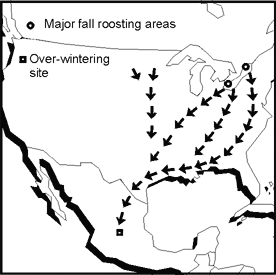
Resources | Coastal Flora and Fauna
Monarch Butterfly
The Monarch Butterfly is used as an international symbol of conservation. But in recent years North American populations have been in steep decline. The Monarch Butterfly is now a species at risk.
It is distinctively yellow, white, and black banded at the caterpillar stage. After 9-14 days the caterpillar changes into a showy, large butterfly with bright orange and black wings, bordered with white spots.


The Monarch Butterfly is found all across Canada with the most extensive breeding grounds found in British Columbia and Ontario.
Monarch Butterflies in Southern Ontario make the 4000 km trip to the Oyamel Fir Forests in Central Mexico every fall. They stay there for 6 months to escape the Canadian winter cold.
This migration is also multi-generational. That means Monarchs returning to Canada in the spring are sometimes the great-grandchildren of the Monarchs that left in the fall.
Each adult butterfly lives for two to six weeks, except for the migrating generation, which lives up to seven months through the fall and winter.
Threats
Degradation of overwintering habitat, climate change, use of herbicides and insecticides, and invasive plant species have put this species at risk.
Monarchs access to Milkweed has also dramatically impacted the survival rate of the species. Milkweed is non-resistant to the herbicides and insecticides used on crop fields, lawns, and gardens. Monarchs feed solely on Milkweed in the larvae and caterpillar stages; it is also the only plants where Monarchs can lay their eggs successfully.
How You Can Help
-
Learn more about the Monarch Butterfly and other endangered and threatened species. Understand how the destruction of habitat leads to loss of endangered and threatened species and Canada’s plant and animal diversity. Tell others about what you have learned.
-
Join a conservation group active in local shore conservation.
-
Plant native Milkweed
-
Avoid using insecticides and herbicides on your lawns and gardens
-
Report Monarch sightings (including eggs, larvae, and caterpillars), as well as milkweed sightings, on the Mission Monarch Website
Additional Resources
Learn more about the Monarch Butterfly
Report Monarch and Milkweed sightings to the Mission Monarch Website
How to plant Native Milkweed for Monarch Butterflies
.png)